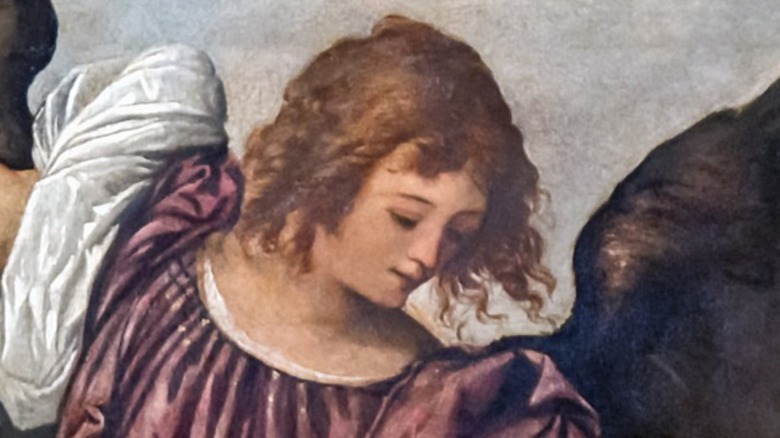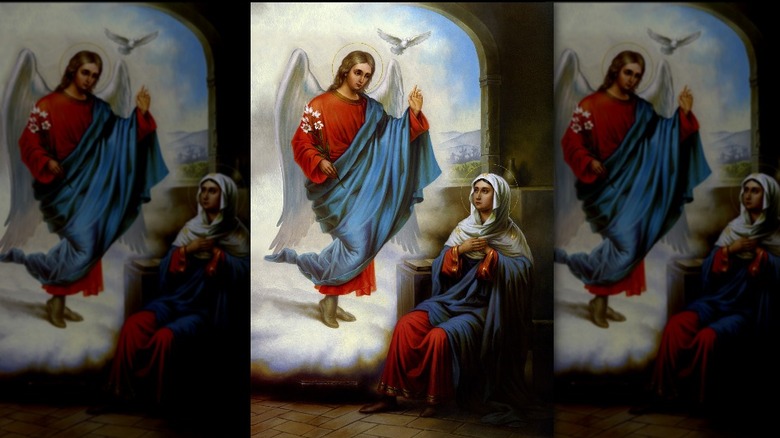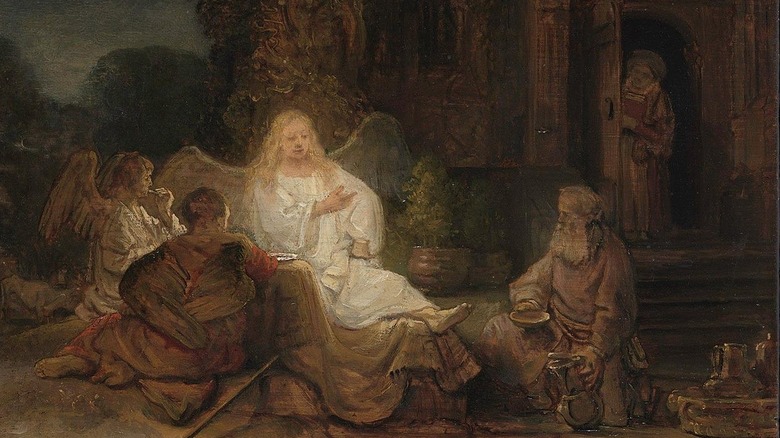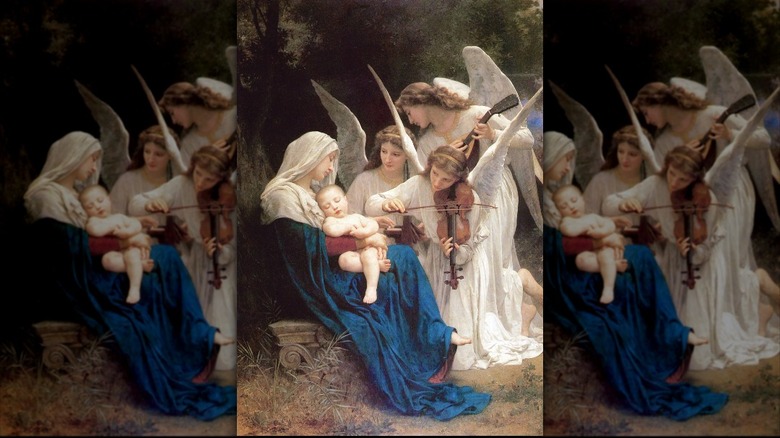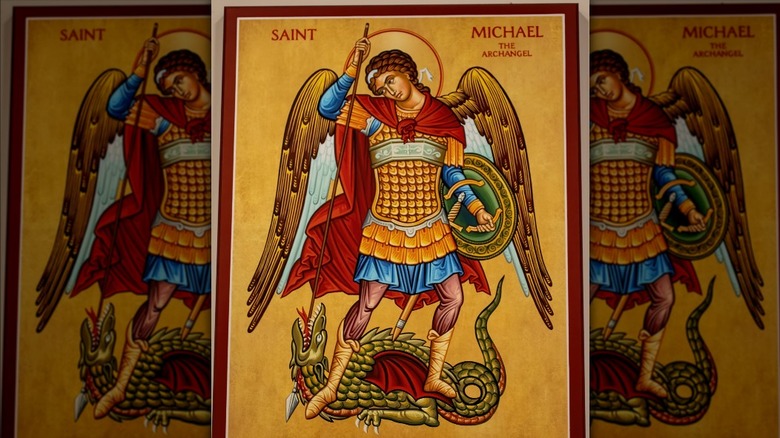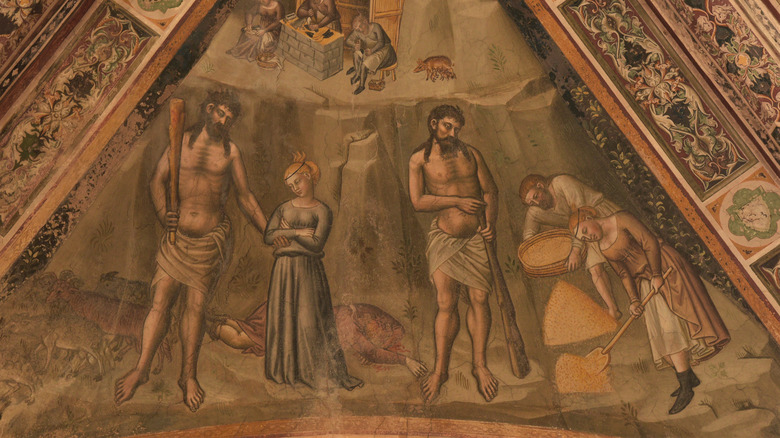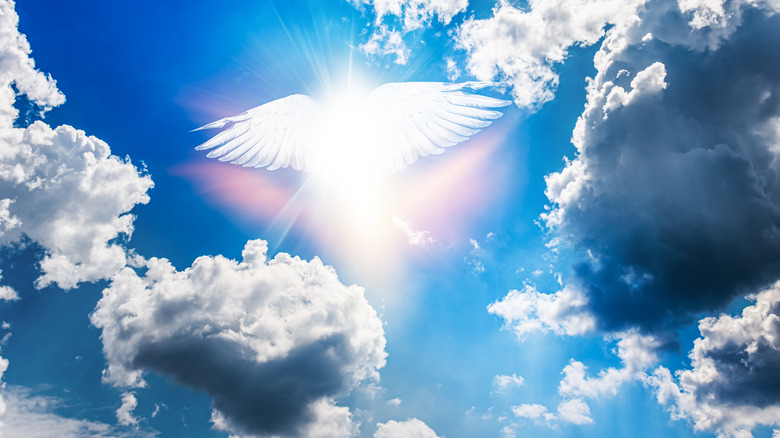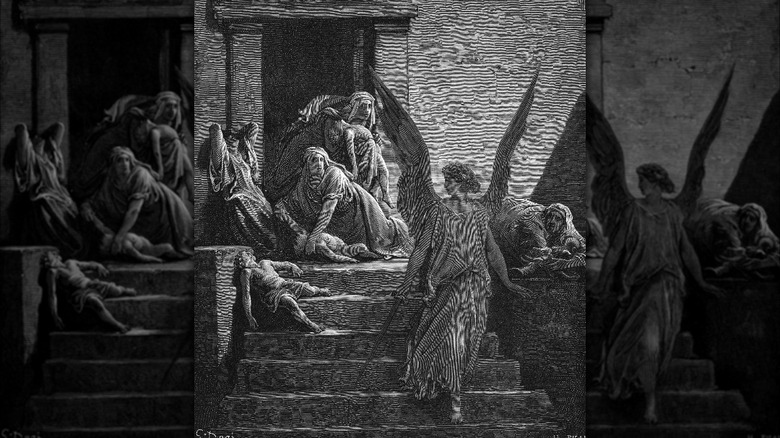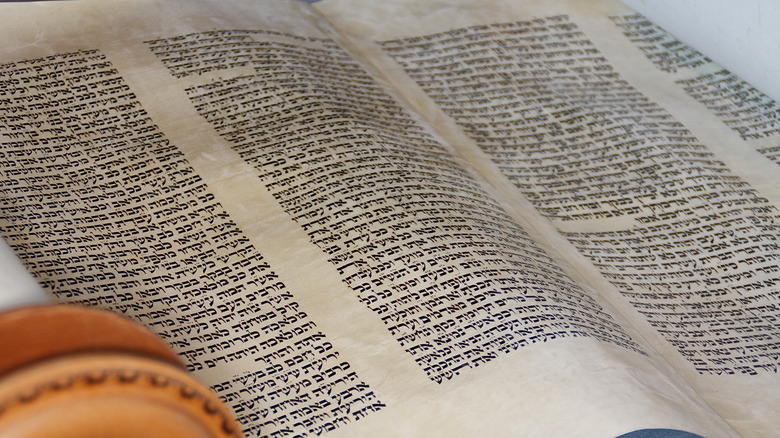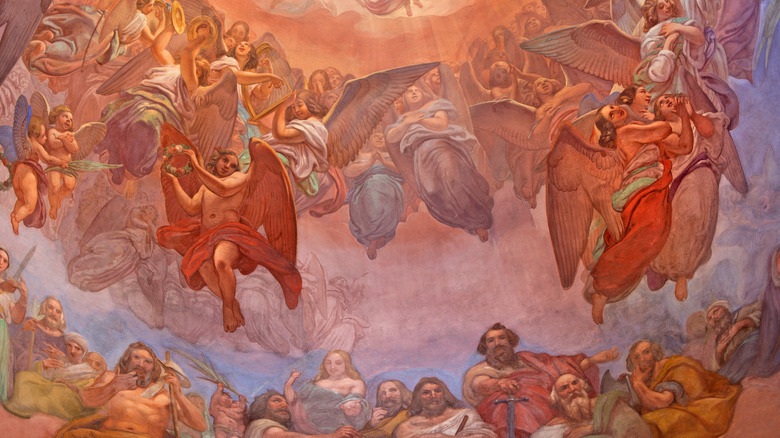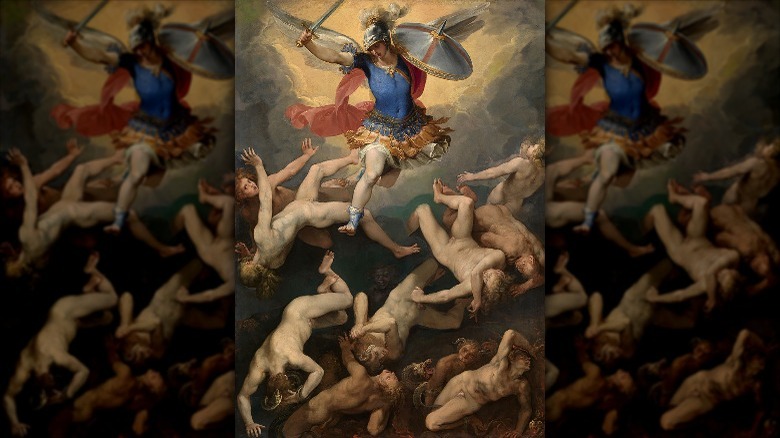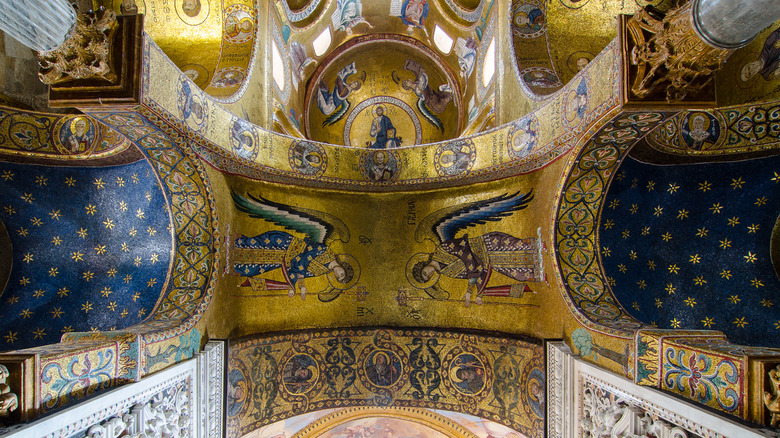Things People Get Wrong About Angels
Angels occupy a special place in Western thought among Christians, Jews, and Muslims. In popular imagination, these beautiful, winged creatures, clad in white and bathed in the light of heaven are the protectors of humans. This is best reflected in the Christian belief in guardian angels, who, according to Catholic Online, are supposed to protect their wards from evil and guide them along righteous paths.
But angels are also some of the most misunderstood beings of the biblical world. While they are portrayed as benevolent guardians (and often they are), serenading the world with music from heaven, they are also capable of extreme violence in particular circumstances. Neither are all angels good, and many forget that the most evil being of the world was once a beautiful and faithful angel himself. From the very meaning of the word to the way they are organized, misconceptions persist in popular understanding of angels. Here are some of the many things people get wrong about these divine and awe-inspiring servants of God.
Angels are a type of being
In popular imagination, angels are winged, heavenly beings that protect people against evil. Generally, they are thought of as some sort of separate being from humans, and in a sense they are. But the term "angel" is not used to describe the separation between humans and these heavenly beings. Instead, the term is a job description that explains what these heavenly beings do.
According to Strong's Bible Concordance (via Bible Hub), the Greek term "aggelos," the root for the English word "angel," simply means messenger. In the Old Testament, the Hebrew word for angel, according to Chabad, has the same meaning. Hence, an angel is simply one of God's messengers. So what does this job entail? It depends on the angel's rank. According to Catholic Straight Answers, there are nine types of angels with different assigned roles in the angelic hierarchy. Some angels are close to God and look upon him in adoration. Others are tasked with supervising lower-ranking angels, who serve as intermediaries between God and Man. These angels are responsible for delivering God's orders directly to their recipients. Chabad notes that God "pre-programmed" his angels for specific purposes. For instance, the archangel Gabriel is explicitly a messenger, while Raphael's job is to heal. Their specific job descriptions lead to some interesting theology regarding what they can and cannot do.
Angels can multitask
Since angels are powerful heavenly beings endowed by God with certain abilities, one would expect them to be able to do basic things that humans can do. But interestingly, angels are limited in their powers, and are incapable of simple things such as multitasking. This limitation is perhaps best illustrated in the Book of Genesis. In Genesis 19, three angels of the Lord visit Abraham to inform him that his wife is pregnant, Sodom will be destroyed, and he will be healed. According to Chabad, Jewish commentators have noticed that one angel could theoretically have accomplished all three of these orders. Yet, for some reason, God sends out three, one for each task at hand.
Jewish commentators are not in full agreement, but Rabbi Menachem Feldman (via Chabad) suggests that the ability to only perform one task at a time is one of the defining characteristics that makes angels so special. Angels were created to serve God. When assigned a task, an angel must throw itself wholeheartedly into its mission to serve God properly, something that humans should aspire to imitate. Feldman suggests that perhaps the Jewish commentators extrapolated an important life lesson from angels' inability to multitask. Humans must, at times, forget how to multitask to tune out distractions that stop them from serving and adoring God. Thus, when focused on God, they become more like the angels, who serve God wholeheartedly and exist solely for that purpose.
Angels are physical beings
Angels have been portrayed in a variety of ways. The most common is that of a graceful, feminine (but not necessarily female) winged being, which, according to the Catholic Encyclopedia, originated in the Late Roman Empire. Popular imagination has long held fast to this kind of image, which is beautifully encapsulated in Adolphe-William Bouguereau's painting the Virgin of the Angels (pictured above). But these are just popular representations that do not represent angels' bodily form. According to both Jewish and Christian theology, angels are not physical beings.
Jewish magazine Aish perhaps best sums up what angels are like physically. According to Judaism, "real angels" do not have "bodies, wings, or one drop of physicality." This belief has entered Christianity as well. According to the Catholic magazine Compass News, angels are purely spiritual beings with no real physical form. But per First Things, this has a number of implications. Since angels do not have bodies, they cannot partake in basic human activities that entail the use of body parts (which angels do not have). Thus, an angel cannot "eat, sleep, smile, laugh, marry, make love, or have children."
If angels are not physical beings, how can they appear to people, as they do repeatedly in the Bible? According to Compass News, angels can take human form in order to deliver revelations or carry out God's orders. But this is all a facade. Catholic Answers notes that humans often require images to understand that which they cannot see, and thus, feminine imagery was used to describe these beings, whom the Bible describes as "light."
Angels are male or female
Angels are often depicted as gendered beings. A famous misconception (via EWTN) claims that every boy gets a male guardian angel and every girl a female one. According to Christianity Magazine, angels are often depicted as female, or at least as feminine. Adolphe-William Bouguereau's painting the Virgin of the Angels is an excellent example of this trend. The angels serenading Mary and Jesus appear highly feminized. These depictions likely originate in Greco-Roman paganism, per Christianity Today. After the coming of Christianity, angels were assimilated into the winged goddesses of the old pantheons.
Contrary to popular art, biblical angels are always described as male, perhaps because the Greek and Hebrew words for angel are both masculine. The main archangels — Michael, Raphael, and Gabriel — all have masculine names. Judges 13, meanwhile, describes an angel as "a man of God." It seems pretty straightforward. Angels must be male, right?
The truth is that according to Jewish and Christian tradition, angels are neither male nor female. The distinction between male or female in Christianity is a physical question that depends upon genetics. According to Catholic Answers, the female-male dichotomy is closely tied to reproduction and the physical human body, which distinguishes the two genders through physical characteristics related to reproduction. As noted earlier, however, angels do not have bodies. Without bodies, they cannot be distinguished sexually or engage in reproduction, precluding them from such categorization.
There are exceptions to the rules?
The above rules are fairly absolute when describing angels, but there is a portion of Genesis that seems to contradict these rules according to certain interpretations. In Genesis (via Chabad), there is a brief and hotly-debated account about a group of males called "the sons of nobles." These beings mated with the "daughters of man" and sired a race of giants called the Nephilim. But other Bible translations such as the NIV call them "sons of God" instead. So who were these "people"? One Jewish tradition suggests that they were angels.
According to Chabad, one Jewish tradition identifies the fathers of the Nephilim as two angels. This angelic pair went down to earth with God's permission, where they fell victim to their inclination towards sin. God knew this would happen, but let them go anyway. This interpretation suggests that angels would have a physical form that makes them capable of reproduction, in contradiction of both Jewish and Christian teachings.
So how do Christians and Jews deal with the apparent contradiction? According to Catholic Answers, early Christians rejected the idea of human-angel hybrids. These "sons of God" were equated with mortal men. In Judaism, the question is still open. The Torah Magazine notes that rabbis debated this story fiercely in late antiquity. The consensus rejected angel-human hybrids. But Professor Rachel Adelman (via The Torah) notes that it may be a very old Jewish myth that the rabbis of late antiquity sought to suppress because of its resemblance to pagan myths from the Ancient Near East.
Humans become angels after death
According to Faith Magazine of the Diocese of Lansing, a popular saying posits that when someone dies, "heaven [gains] another angel." This saying is interpreted to mean that the dead join God in heaven as angels. This may be of comfort to grieving relatives, but it is a myth, albeit a persistent and widespread one. It is based on the twisting of one of Jesus' sayings through the omission of a single word.
Faith Magazine notes that humans and angels are two separate types of creation, each special in its own way and made for different purposes. One cannot become the other. Humans do not stop being human in death. While their bodies decay, their souls face God's judgement. Becoming an angel would mean to stop being human, throwing the natural order of things into flux. So where did this persistent myth come from? The source of the controversy is Mark 12:25. In this passage, Jesus discusses the afterlife and the resurrection of the dead. When the dead are resurrected, according to Christ himself, they will not marry. Instead, they will be "like the angels in heaven" (what a difference one word makes!) Matthew Henry's Concise Commentary of the Bible (via Bible Hub) notes that, historically, this passage is interpreted to mean that in heaven, spiritually pure human souls will be like angels because they will be unconcerned with all the activities of the world and flesh (sex, food, drink, etc.) But nowhere does it say that humans will become angels.
Angels are peaceful beings
Angels are popularly thought of as peaceful, benevolent beings. In English, the word "angelic," according to Merriam-Webster, is used to describe something or someone resembling an angel in "purity, holiness, innocence, or beauty." Now, angels fit all of these characteristics. But they can also inflict violence and vengeance on God's behalf. The Bible provides numerous instances of angels committing gruesome violence against God's enemies, from small-scale violence against individuals to mass killings of entire cities and nations in pursuit of God's justice.
The story of Passover is an excellent example of angelic violence (sounds like an oxymoron!) According to the British Library, when Pharaoh refused to let the Hebrews leave Egypt, God ordered the angel of death to kill the firstborn sons of Egypt. But soon, Moses himself drew angelic ire. According to Chabad, the archangel Uriel nearly killed Moses. His wife Zipporah circumcised their son and forced Uriel to relent, saving Moses from the divine wrath. Even Zechariah, father of John the Baptist, was punished for doubting God's word delivered via the archangel Gabriel. According to Catholic Courier, when the old man learned his wife Elizabeth was pregnant, despite her advanced age, he doubted the archangel's words. As punishment, Gabriel rendered him mute and only restored his speech faculties when he obeyed the divine order to name his son John. But despite the capacity for violence, angels that serve God are not evil or malevolent. They are simply doing their jobs in executing God's "perfect will," according to Catholic Link.
The term 'archangel' appears in the Old Testament
There are different categories of angels. The best known, yet often misunderstood, are the archangels. This term does not appear in the Bible until the New Testament. This makes sense, as archangel is a Greek word (via Aleteia), and the New Testament was written in Greek. However, according to Chabad, the Hebrew Old Testament does not distinguish them with an equivalent word, despite the many appearances of angels and archangels. So how are archangels referred to in the Old Testament?
According to Christianity Magazine, the term "archangel" appears a grand total of two times in the New Testament, and only Michael is referred to as such in the Epistle of Jude. The other reference is from Thessalonians and does not name any particular archangel. New Testament evidence, however, suggests that the archangels are a group, even if they are not referred to this way in the original Hebrew.
Although the Hebrew does not use any term to classify the archangels, they are distinguished from lesser angels in other ways. The archangel Michael, for instance, is referred to as the "Great Prince" in Daniel 12:1, implying that he occupies a higher position relative to some other group of angels. In the Book of Tobit, the archangel Raphael explicitly reveals himself as "one of seven angels who stand ready and enter before the glory of the Lord." This latter reference in the Bible provides the earliest background for a group of angels that outranked others, although in the end, archangels are still relatively low down in the angelic hierarchy.
Archangels are the highest ranking angels
The very term "archangel," according to Christianity Magazine, literally means "chief angel" and suggests that these angels are the highest-ranking angels of heaven. But in reality, they are quite low down in the angelic hierarchy. According to Aleteia, the highest ranking angels — who occupy the top three ranks of the hierarchy — are the seraphim, the cherubim, and the throne angels. They worship God directly and serve him. The seraphim, in particular, are closest to God and burn with a fiery passion in their love for him. Following the top three tiers of angels are another three middle-ranking groups, whom Aleteia refers to as a sort of "middle management." At the second lowest position are the archangels, who fall below the angels that watch over principalities but above guardian angels.
Despite their relative low position in the angelic hierarchy, the archangels are still very important. Archangels and their servants below them are the only two groups of angels that interact directly with humans on God's behalf. They are the chief messengers in the truest sense, bearing God's instructions or executing his will on earth, making them key players to moving salvation history forward. After all, without the archangel Gabriel, there would not have been an Annunciation or a Christ.
Lucifer was an archangel
Lucifer, also known as Satan or the devil, was once an angel himself. He is sometimes popularly thought of as a member of the cohort of archangels. St. Michael the Archangel School, for instance, lists Lucifer as "another archangel." But this is not quite accurate. The archangels are among the lowest-ranking archangels; Lucifer, however, was one of the highest-ranking angels in God's heavenly kingdom.
According to the CERC, Lucifer was a member of the seraphim, the highest-ranking angels in God's inner circle that had the privilege of adoring God and looking upon his face. As such, according to Aleteia, Lucifer's job was to adore God with a burning passion. According to Christianity Magazine, the Book of Ezekiel described Lucifer as "the seal of perfection, full of wisdom and perfect in beauty." But because of his gifts, Lucifer grew proud and jealous of God. Eventually, he decided that he was above serving God and desired God's glory for himself. He then rebelled against God, but was soundly defeated in the war that followed.
As punishment for his rebellion, Lucifer and the other rebels were cast into hell. This is likely the source of confusion relating to Lucifer's rank. According to Art UK, it was St. Michael the Archangel who cast Lucifer into hell, as depicted in Giuseppe Cesari's painting (shown above). The two angels, however, were not equals. In the end, the lesser angel defeated the former seraphim, leaving Lucifer to reign in hell over the souls of the damned.
Christians agree on the archangels' names
The archangels have played key roles in salvation history. From St. Michael's defeat of Lucifer to Gabriel's announcement of Mary's pregnancy and the impending birth of Christ, the world of the Bible depends on them to keep moving forward. Given their importance, one would expect Christians to agree on their identities. But they do not. Different Christian denominations recognize different archangels, drawing from both biblical and extra-biblical traditions. According to Aleteia, Christians agree that there are seven archangels. But the Bible only names three. According to Catholic Online, the Catholic Church, in keeping with biblical tradition, only recognizes the names of these three angels — Gabriel, Michael, and Raphael. The church acknowledges the existence of the other four, just not by name. The Eastern Orthodox Church and Anglicans recognize a fourth archangel, Uriel, who, according to Christianity Magazine, appears in non-canonical texts. According to Christianity in View, the Protestant 66-book Bible omits the Book of Tobit, and since Raphael appears in Tobit, some Protestants do not recognize him by that name.
While the Orthodox and Western churches limit themselves to at most four archangels, the Coptic Orthodox Church recognizes the names of all seven archangels. According to the SS Mary and Joseph Coptic Orthodox Church, the names of the three missing archangels are Sarathiel, Sedakiel, and Ananiel. But these names are drawn from tradition, not the Bible. So which names are correct? It is not known for certain, but while the Coptic Church fully embraces traditions in this regard, the other churches are more cautious.
